
CENTRAL MONGOLIA
Central Mongolia is beautiful, pristine and rich in wild species and has been keeping many important historical and cultural remains of different historical periods. In central Mongolia, you can discover distinctive natural zones of forested steppes, mountain steppes and mini version of the Gobi desert and their breathtaking natural beauties and interesting cultural and historical items.
Places to visit: Khangai mountains, Khogno Khan Natural Reserve, Elsen Tasarkhai sand dunes, Ancient capital of Mongol empire Karakorum, Buddhist monastery Erdene Zuu, Tuvkhun monastery, Tsenkher hot spa, Khushuu Tsaidam Monument, Orkhon waterfall, Naiman Nuur National Monument, Ogii lake, Khorgo-Terkh National Park.
Activities: Hiking, horse riding, camel riding, experiencing nomadic culture, monastery visiting, sightseeing, fishing, bird watching, camping in the wild.
Khogno Khan Natural Reserve & Elsen Tasarkhai sand dunes
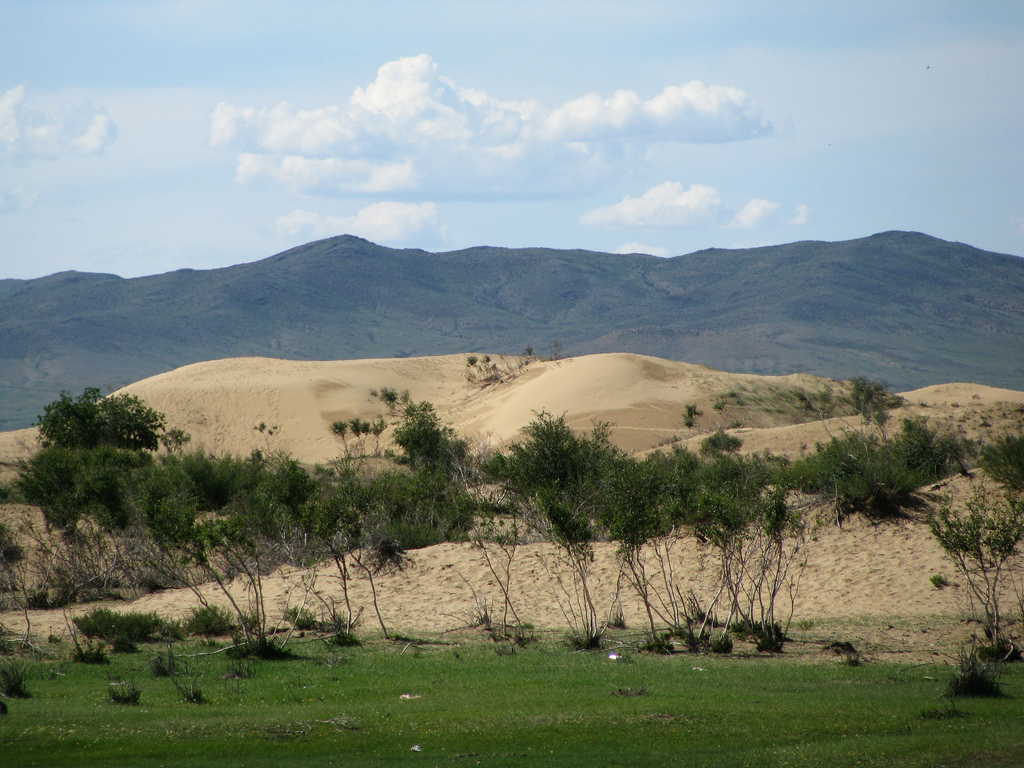 Khogno Khan Natural Reserve covers 46,990 hectares of land and is located in Rashaant county of Bulgan province. The taiga and steppe plants grow in this area and represent two or three different natural zones. This area was taken under state protection in 1997. Khogno Khan, a splendid mountain is situated in the border area of Uvurkhangai, Tuv and Bulgan province. This is a magnificent place with mountains, forests, steppes, Gobi-type desert and mineral water sources all in one location. There are many wild animals such as wolves, deers, foxes and snow leopards inhabited here. In Khogno Khan Natural Reserve, there is an extraordinary sand dunes called Elsen Tasarkhai. "Elsen tasarkhai" is a part of the Great Mongolian Sand dunes and extends about 80 km. The scenery is a perfect combination of desert, picturesque mountains, river and green grassland. One of the main attractions of this area is Uvgun monastery which was built in 17th century by Saint Zanabazar who was a great sculptor and the biggest representative of Buddhism in Mongolia. During Middle Age feuds between Western and Eastern Mongolians (Dzungaria and Khalkh Mongolia) after the collapse of the Mongol Empire, the armies of Dzungarian leader Galdan Boshigt noticed the golden roofs of the temples in Khogno Khan Mountain and massacred the partisan-monks of the rival Zanabazar in 1640, killing them by tying their necks with a rope (the Mongolian verb for the action is khognokh) as if they were goats and sheep. This is the meaning of name of the mountain. After democratic revolution in 1990 the monastery was restored by the granddaughter of the monks who was living at the monastery. This area is pleasant for many activities such as hiking, mountain climbing and horse riding.
Khogno Khan Natural Reserve covers 46,990 hectares of land and is located in Rashaant county of Bulgan province. The taiga and steppe plants grow in this area and represent two or three different natural zones. This area was taken under state protection in 1997. Khogno Khan, a splendid mountain is situated in the border area of Uvurkhangai, Tuv and Bulgan province. This is a magnificent place with mountains, forests, steppes, Gobi-type desert and mineral water sources all in one location. There are many wild animals such as wolves, deers, foxes and snow leopards inhabited here. In Khogno Khan Natural Reserve, there is an extraordinary sand dunes called Elsen Tasarkhai. "Elsen tasarkhai" is a part of the Great Mongolian Sand dunes and extends about 80 km. The scenery is a perfect combination of desert, picturesque mountains, river and green grassland. One of the main attractions of this area is Uvgun monastery which was built in 17th century by Saint Zanabazar who was a great sculptor and the biggest representative of Buddhism in Mongolia. During Middle Age feuds between Western and Eastern Mongolians (Dzungaria and Khalkh Mongolia) after the collapse of the Mongol Empire, the armies of Dzungarian leader Galdan Boshigt noticed the golden roofs of the temples in Khogno Khan Mountain and massacred the partisan-monks of the rival Zanabazar in 1640, killing them by tying their necks with a rope (the Mongolian verb for the action is khognokh) as if they were goats and sheep. This is the meaning of name of the mountain. After democratic revolution in 1990 the monastery was restored by the granddaughter of the monks who was living at the monastery. This area is pleasant for many activities such as hiking, mountain climbing and horse riding.
Karakorum
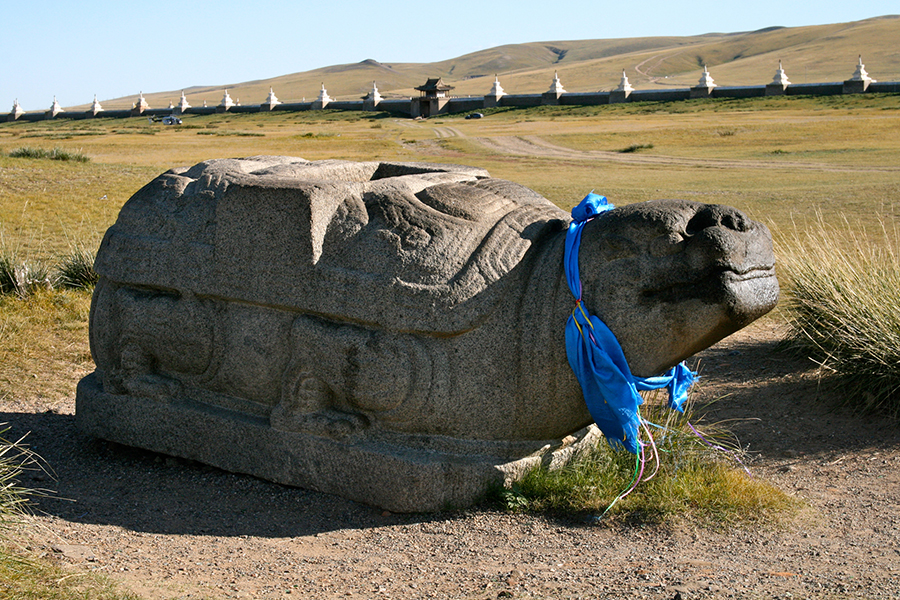 Karakorum, ancient capital of Mongol empire, was established by Chinggis Khan in 1220 in the Orkhon valley at the crossroads of the Silk Road. Karakorum was a busy spindled city with high civilization built by the best artists and masters of antiquity.The ancient capital served as the political, cultural and economic capital of the Mongols for 40 years until Khublai Khan moved it to Khanbalik, in what is now Beijing. Following the move to Beijing, Karakorum was abandoned and then destroyed by the soldiers from Ming Dynasty in 1388. The remains of the capital that stood at the crossroads of the Silk Road are extensive underground archaeological assets and two granite turtles that once stood at the main gate to the city. Four of these turtle sculptures used to mark the boundaries of ancient Karakorum, acting as protectors of the city (turtles are considered as symbols of eternity). Later in 1586, Erdene Zuu, the first Buddhist monastery in Mongolia, was built on the ruins of the 13th century capital city. Nowadays there is small town called Kharkhorin, which is 360 km from Ulaanbaatar city. Kharkhorin is located at the lower end of the upper valley of the Orkhon River, which is part if the World Heritage Site Orkhon Valley Cultural Landscape.
Karakorum, ancient capital of Mongol empire, was established by Chinggis Khan in 1220 in the Orkhon valley at the crossroads of the Silk Road. Karakorum was a busy spindled city with high civilization built by the best artists and masters of antiquity.The ancient capital served as the political, cultural and economic capital of the Mongols for 40 years until Khublai Khan moved it to Khanbalik, in what is now Beijing. Following the move to Beijing, Karakorum was abandoned and then destroyed by the soldiers from Ming Dynasty in 1388. The remains of the capital that stood at the crossroads of the Silk Road are extensive underground archaeological assets and two granite turtles that once stood at the main gate to the city. Four of these turtle sculptures used to mark the boundaries of ancient Karakorum, acting as protectors of the city (turtles are considered as symbols of eternity). Later in 1586, Erdene Zuu, the first Buddhist monastery in Mongolia, was built on the ruins of the 13th century capital city. Nowadays there is small town called Kharkhorin, which is 360 km from Ulaanbaatar city. Kharkhorin is located at the lower end of the upper valley of the Orkhon River, which is part if the World Heritage Site Orkhon Valley Cultural Landscape.
Erdene Zuu monastery
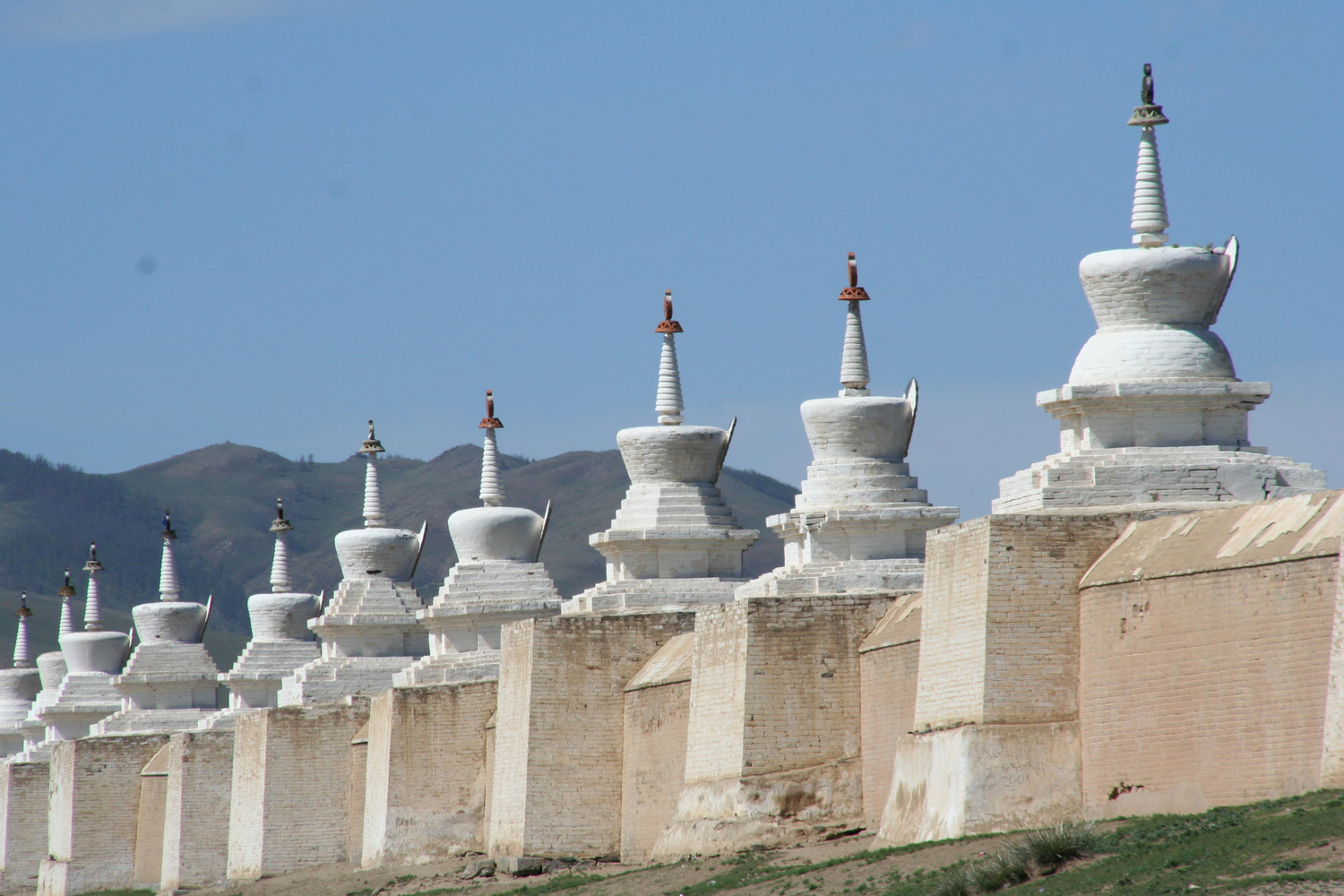 Erdene Zuu Khiid - The first Buddhist monastery called Erdene-Zuu was built on ruins of Karakorum. It was built in 1586 at the initiative of Abtai Khan, most influential Prince of that time in Mongolia.The monastery occupies an area surrounded by a stone wall with 108 stupas lining on it. The Erdene-Zuu monastery preserves marvelous works of Mongolian artists, painters, cutters, sculptors, embroiders and craftsman of the XVII-XIX centuries. It had between 60 and 100 temples, about 300 gers inside the walls and, at its peak, up to 1000 monks in residence. Erdene Zuu Monastery was destroyed by communists in 1930s during the political purge. Suprisingly, many Buddha images and statues, tsam masks and thangkas were saved by locals. The monastery was closed until 1965 and reintroduced as a museum to public. After democratic revolution in 1990, religious freedom was restored and monastery became active again.
Erdene Zuu Khiid - The first Buddhist monastery called Erdene-Zuu was built on ruins of Karakorum. It was built in 1586 at the initiative of Abtai Khan, most influential Prince of that time in Mongolia.The monastery occupies an area surrounded by a stone wall with 108 stupas lining on it. The Erdene-Zuu monastery preserves marvelous works of Mongolian artists, painters, cutters, sculptors, embroiders and craftsman of the XVII-XIX centuries. It had between 60 and 100 temples, about 300 gers inside the walls and, at its peak, up to 1000 monks in residence. Erdene Zuu Monastery was destroyed by communists in 1930s during the political purge. Suprisingly, many Buddha images and statues, tsam masks and thangkas were saved by locals. The monastery was closed until 1965 and reintroduced as a museum to public. After democratic revolution in 1990, religious freedom was restored and monastery became active again.
The monastery is enclosed in an immense walled compound surrounded by 108 stupas. The three temples in the compound, which were not destroyed in the 1930s, are dedicated to the three stages of Buddha's life: childhood, adolescence and adulthood.
Dalai Lama Temple was built in 1675 to commemorate the visit by Abtai Khan's son, Altan, to the Dalai Lama in Tibet. The temple accommodates statue of Zanabazar and some fine 17th-century thangkas depicting the Dalai Lamas and various protector deities.
Khushuu Tsaidam Monument
Khushuu Tsaidam Memoral Complex is a Turkic inscribed monument of Turkic Empire. The inscription was written by the grandson of Kultegin and devoted to the Bilge khan of Turkic Empire and his brother Kultegin in 732. Bilge Khan's stele, well khown Orkhon Inscription is 3,3 m high, 1,3 m wide and has 68 rows of inscription. Bilge Khan, who was the latest King of Turkic Empire, ruled its country for 19 years. During the excavation of the memorial in 31th of July 2001, over 2000 finds were revealed and the most important one among them was a gemstone inlaid golden crown of Bilge Khan. There are over 40 runic stele in Mongolia and about 10 of them are located only in Orkhon Valley, that is why it was named Orkhon inscription. These 2 stele of Bilge Khan and Kultegin are 1 km apart from each other. These memorials were recognized as a "Cultural landscape" of the UNESCO World Heritage in 1996, although they had been destroyed much throughout its history of over thousand years.
Ogii Lake
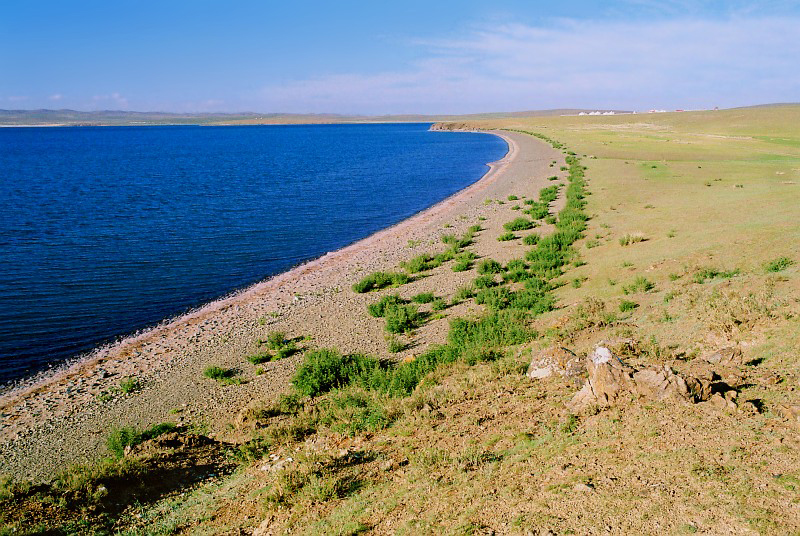 Ogii lake, locates on the centre of Mongolia, in the territory of the Arkhangai province, is one of the biggest lakes of Mongolia and has 27 km squire area. Average depth is 6.64m, in some sections 15.3m, coastal length is 23.5m. The lake abounds in various types of fish and birds, which create an incredible natural beauty. There are 150 sorts of extremely rare and rare species birds of passage come to settle down on the Ogii lake. It is home for cranes and ducks, also Swan Goose, White Spoonbill and Dalmatian Pelican have been recorded. Ogii lake has 14 sorts of fish belonged to the North Atlantic ocean area such as Esoc lucius, Rutilus lacustrisi, Perca fluviatilis, Leucisous idus, Cyprinus carpio haematopterus and so on. Delicate sand and whetstone coast, the soft wave makes an area is very convenient to have boat adventure. Also it is enthusiastic place for swimming, having sunbath, bird watching, fishing, horse and camel ridding and hiking.
Ogii lake, locates on the centre of Mongolia, in the territory of the Arkhangai province, is one of the biggest lakes of Mongolia and has 27 km squire area. Average depth is 6.64m, in some sections 15.3m, coastal length is 23.5m. The lake abounds in various types of fish and birds, which create an incredible natural beauty. There are 150 sorts of extremely rare and rare species birds of passage come to settle down on the Ogii lake. It is home for cranes and ducks, also Swan Goose, White Spoonbill and Dalmatian Pelican have been recorded. Ogii lake has 14 sorts of fish belonged to the North Atlantic ocean area such as Esoc lucius, Rutilus lacustrisi, Perca fluviatilis, Leucisous idus, Cyprinus carpio haematopterus and so on. Delicate sand and whetstone coast, the soft wave makes an area is very convenient to have boat adventure. Also it is enthusiastic place for swimming, having sunbath, bird watching, fishing, horse and camel ridding and hiking.
Naiman Nuur Region- 8 Lakes Region
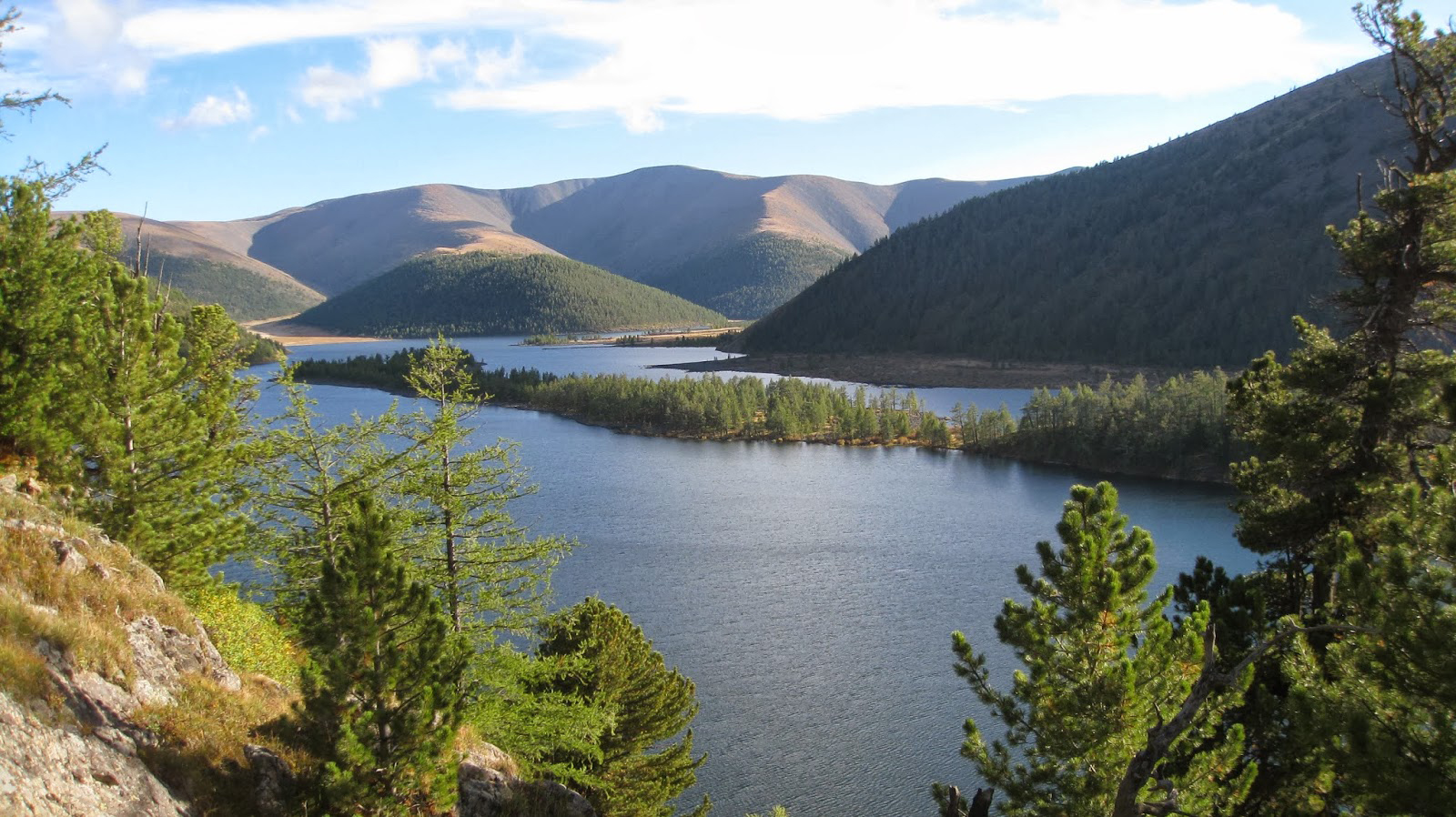 The Khuisiin Naiman Nuur National Monument is located in the Central Mongolian Khangai Mountain range and represents a typical high mountain area of Mongolia with max. The area of Naiman Nuur (Eight Lakes), which was created by volcanic eruptions centuries ago, is located on over 2,400 meters above sea level. The area of 11,500 hectare size was declared a National Monument in 1992. The Eight Lakes area is about 35 km southwest of Orkhon Waterfall, but the roads are often virtually impassible. The lakes are named Shireet, Khaliut, Bugat, Khaya, Khuis, Onon, Doroo and Bayan- Uul. The lakes located in a high mountain area with sub alpine mountain meadows and coniferous forests of Siberian Pine and Siberian Larch, flat valley areas with lava stone fields in the north of the protected area and barren mountain tops, and the lakes. In this area, there are 50 species of birds from 22 families have been recorded such as Black-throated Diver, Great Cormoran, Bar-headed Goose and Whooper Swan.
The Khuisiin Naiman Nuur National Monument is located in the Central Mongolian Khangai Mountain range and represents a typical high mountain area of Mongolia with max. The area of Naiman Nuur (Eight Lakes), which was created by volcanic eruptions centuries ago, is located on over 2,400 meters above sea level. The area of 11,500 hectare size was declared a National Monument in 1992. The Eight Lakes area is about 35 km southwest of Orkhon Waterfall, but the roads are often virtually impassible. The lakes are named Shireet, Khaliut, Bugat, Khaya, Khuis, Onon, Doroo and Bayan- Uul. The lakes located in a high mountain area with sub alpine mountain meadows and coniferous forests of Siberian Pine and Siberian Larch, flat valley areas with lava stone fields in the north of the protected area and barren mountain tops, and the lakes. In this area, there are 50 species of birds from 22 families have been recorded such as Black-throated Diver, Great Cormoran, Bar-headed Goose and Whooper Swan.
Khuisyn Naiman Nuur National Monument with its exceptional configuration is surrounded by the beautiful nature of the middle part of the Khangai mountain range. Area is paradise for adventurous travelers, who likes trekking and horse back riding trips.
Orkhon Waterfall
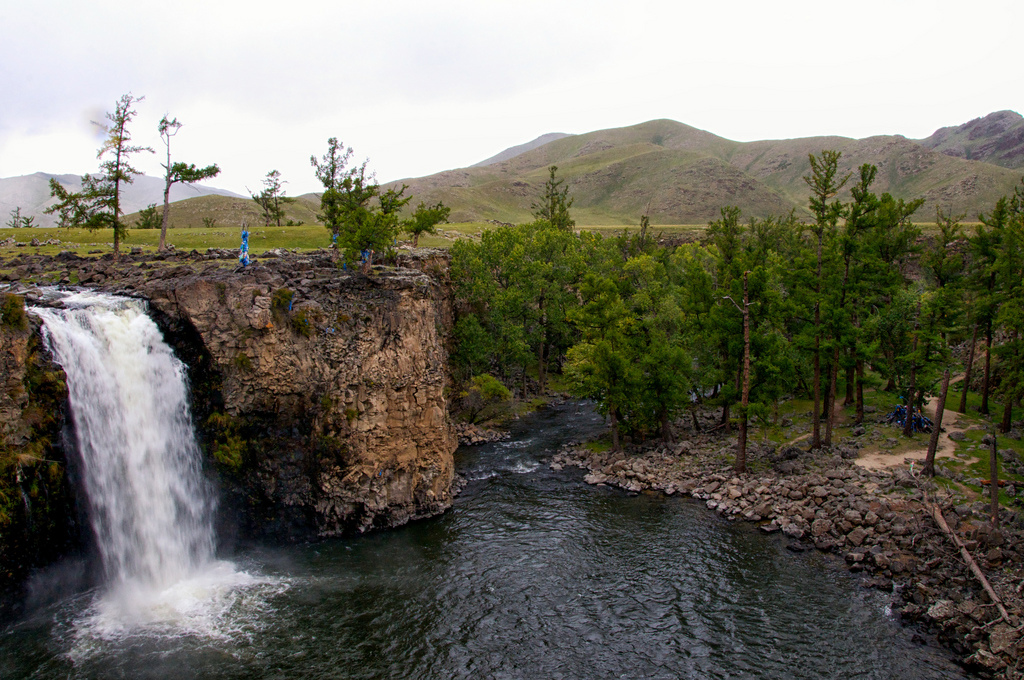
The surrounding areas of the waterfall was formed by volcanic activities dated back approximately 20,000 years (possibly Quaternary period). Orkhon is longest river in Mongolia with length of 1124 kilometers (709 miles) and formulates by springs at the numerous mouths of Suvraga Khairkhan a peak of Khangai mountain range. Flows of Orkhon River created a 130 km long canyon through the lava plateau.
The area is ideal for fishing, horse riding, cycling and photography. The rivers have handful species of river fish such as pike, sturgeon, hucho taimen, common asp, Siberian grayling, roach etc. Scenic and untouched natural distinct spot allow good opportunities for hiking and horseback riding. This valley is known as the home of Mongolian nomadic culture as many of Mongolia’s ancient monuments lie within its borders. Yak herder nomads are common. Because cars cannot drive to in, Trekking tours to Naiman nuur region (Eight Lakes) are always organized from here by the support of locals who hire their trained horses for transportation for luggage.
Tuvkhun Monastery
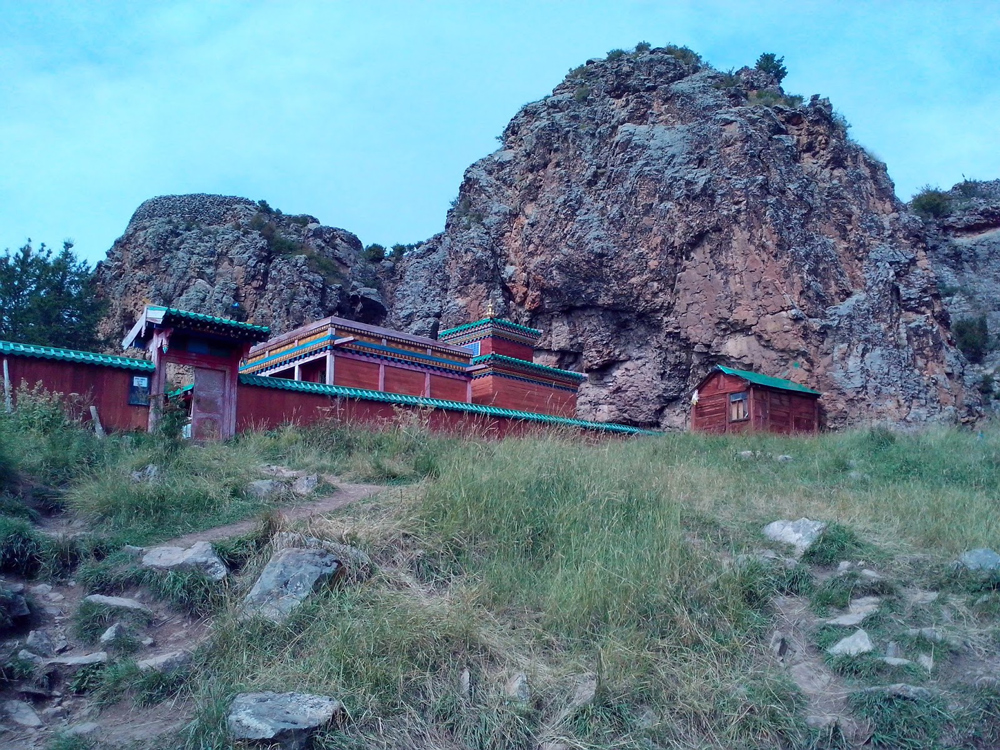
One of most beautiful monastery complex is situated on a forested rocky mountain called Shireet Ulaan, which elevated in 2300 meters above sea level.
The monastery was built in 1654 by Saint Zanabazar who was a great sculptor and one of the biggest representatives of Buddhism in Mongolia. Upon his return in 1651 from his first trip to Tibet he had a small walled stone meditation hut built here. 1653, he visited Erdenezuu, founded by his great grandfather, and appeared before a convocation of khalkha nobility. While there he prevailed upon his followers to build temple and retreat at Shireet Ulaan Uul in his own personal use. Later it became worship where many of his famous artworks were created; including five transcendent Buddha's now located in the Zanabazar Fine Art Museum and Choijim Lama Musuem. Zanabazar also reportedly designed his Soyombo Alphabet while his residing here. During Zanabazar's lifetime retreat was called Bayasgalant Aglag Oron (Happy Secluded Place).
After his death it became Tuvkhun Monastery, the name which it is known today. The small temple was heavily damaged by communists during the upheavals of the late 1930s. During the summer of 1997 extensive ceremonies were performed here and new statue of deity Gombo Makhagal (Mahakala) was placed in top of refurbished and consecrated. Several monks live at the monastery full time.
Khorgo-Terkh National Park
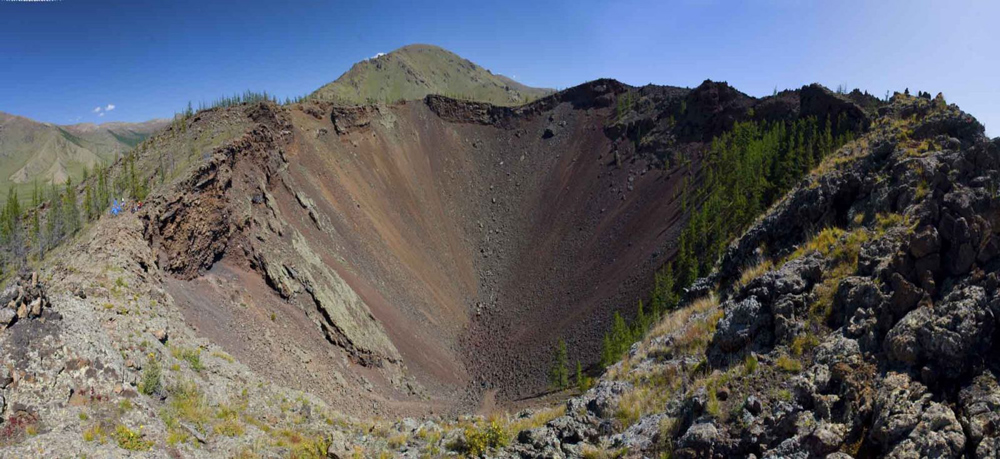
The National Park covers 28 sq.km including Togoo Uul which reaches 2240 m above sea level and Hill of Terkhiin Tsagaan Lake.
It has been protected since 1965, fully in 1997, to safeguard spectacular mountain scenery and endangered flora and fauna. It's surrounded by the Khangai Mountains, which reach as 3000 meters above the sea level. Khorgo Mountain is dead volcano, which lies east of Terkhiin Tsagaan Lake. The mountain is covered with basalt. The volcano crater of the Togoo Uul is 200 meters wide and 100 meters deep.
 Terkhiin Tsagaan Lake is an astonishingly beautiful lake with relatively pure fresh water. Torrents of lava issuing from the Khorgo volcano blocked the north and south Terkh Rivers, so forming the dammed lake of Terkhiin Tsagaan Lake at an altitude of 2060 meters above sea level. The lake is 16 km wide, 4-10 meters deep with its deepest point at 28 meters and over 20 kilometers in length.
Terkhiin Tsagaan Lake is an astonishingly beautiful lake with relatively pure fresh water. Torrents of lava issuing from the Khorgo volcano blocked the north and south Terkh Rivers, so forming the dammed lake of Terkhiin Tsagaan Lake at an altitude of 2060 meters above sea level. The lake is 16 km wide, 4-10 meters deep with its deepest point at 28 meters and over 20 kilometers in length.
Tsenkher hot Spa
Tsenkher is hot spring, which emerges from the ground at 85 Celsius degree. It is located in Arkhangai province. The waters of the spring contain hydrogen sulfide and considered as having curative properties for joints and other ailments. It is an excellent place to relax.
Recommended


Mongolian winter is the most incredible winter that one might experience and there is plenty to see and enjoy during a winter travel. Glittering white snow, clear fresh air, sun, and little chills are the image of Mongolian winter. Taking this fan...
Duration: 3 Days / 2 Nights
Destination: Gobi - Central


All of Mongolians celebrate the Lunar New Year, which is called in Mongolia “Tsagaan Sar” or the “White Moon”. It is widely celebrated throughout the country around January or February according to the combination of Solar-...




